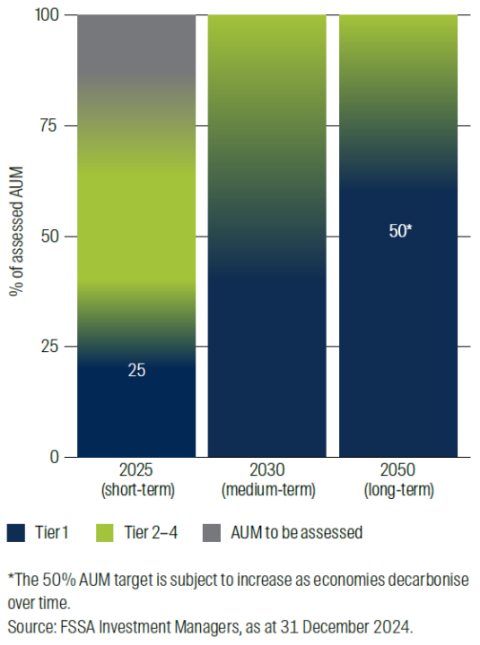
Climate change
Team climate change statement
At FSSA, we have always believed that sustainability challenges and opportunities are a core part of investment fundamentals and can have an outsized impact on a company’s returns. We actively seek to invest in businesses whose sustainable practices and products are able to meet the world’s changing expectations.
This matters to us because as long-term investors, we expect that companies will have to bear the costs of meeting these challenges over the course of our ownership.
Many of the countries we invest in are particularly vulnerable to climate-related risks given their geography and economic sensitivity. Therefore, we expect that every company we invest in will be exposed to some form of climate risk. Specifically, we have large exposures to financial services and consumer staples companies in our portfolios. To assess climate risk in the finance sector, we focus on lending practices and the impact this has on climate change. For consumer staples, the most material environmental topics are raw material use, water management and plastics pollution.
Climate risks – including those related to the transition to low-carbon economies, the physical impacts of climate change, reputational concerns, and regulatory and legal requirements – are all interconnected issues. Of these, we consider transition risks and physical risks to be the most significant to our portfolio and those that we can address directly with companies.
Transition risks are growing in consideration as companies think through the societal and economic shifts toward a low-carbon future. We see them as immediate challenges to address. Whilst our direct exposure to fossil fuels, agriculture and mining is minimal, we acknowledge that these businesses form a meaningful part of our investee companies’ supply chains. We therefore consider these risks from a top-down industry perspective as well as from a bottom-up, company-by-company point of view.
Physical risks refer to the impacts of a changing and volatile climate on existing business practices. As such, we believe this affects all companies – either through their primary business activities or their supply chains and distribution activities.
Beyond these two primary risks, companies also face more stringent regulatory and legal risks, which increases the risk of reputational damage. The governments of countries in which we invest have begun to implement penalties for non-compliance. We fully expect these risks to increase over time.
We identify climate-related risks throughout the research process, from the initial company assessment to the ongoing monitoring and review. We believe the most effective way to identify risks is through regular engagement with company management. This also provides us with an opportunity to assess other “soft factors” and determine whether a company’s efforts to manage climate risks are genuine.
To evaluate a company’s climate-related risks and opportunities and to prepare for these conversations with management, we review company disclosures and note the adherence to the Task Force on Climate-Related Financial Disclosures (TCFD). We also review data from third-party providers such as ISS and MSCI to provide us with a company’s historical carbon intensity and scope 1 and scope 2 emissions. Additionally, we use Sustainalytics and RepRisk, among others, to alert us of significant recent events and controversies. These findings are used to augment our engagement with companies.
Throughout the engagement process we identify areas where companies could improve and offer external resources that may assist in the process. For example, we encourage companies to utilise established frameworks like TCFD and the Science-Based Targets initiative (SBTi) to report on climate-related disclosure and targets.
We do not, at this stage, conduct separate scenario analyses as it relies heavily on unknowable assumptions, particularly around scope 3 emissions.
We manage climate-related risks from both a holistic portfolio perspective and in a bottom-up manner.
From a portfolio perspective, we conduct fund-level sustainability reviews with environmental and social indicators to identify the outliers and laggards, which then focuses our engagement efforts. Specific to climate risks, we review total carbon emissions, trends in emissions intensity, quality of disclosure and alignment to SBTi. We launched a decarbonisation process in 2021 with an assessment of how our holdings were positioned, how they performed at that point in time, and their plans for the future. With our engagement-led process, we started with an assessment of our largest positions, with the aim of driving multi-year emissions reductions. The lowest performing companies in our initial review have been prioritised for more pressing engagement.
From a bottom-up perspective, we integrate climate considerations throughout the research process. With every potential investment, we consider the business model and its exposure to climate-related risks, and decide whether we are comfortable with the level of risk the company faces. Assessing the quality of management is a critical component of our investment process. We look for signs that there is a long-term owner/manager who is passionate about climate issues – or is incentivised to care about this multi-decade challenge.
We may further express our views through votes on company proposals. Whilst we subscribe to proxy voting services such as Glass Lewis and Ownership Matters as a guide, the ultimate decision on how we cast our proxy votes lies with the respective investment analyst.
Our funds tend to have significantly lower carbon intensity than their respective benchmarks. However, we believe this data is best viewed as an output of our investment philosophy, which is centred on assessing the quality of companies holistically rather than selecting only those that perform well on this metric. We are hopeful that as the broader corporate world decarbonises, the gap between the benchmark and our portfolios will gradually close – and improve together.
Our efforts to decarbonise are focused on reducing the total carbon emissions of our holdings. We remain committed to increasing our engagement on climate change matters and to underscore the importance of having credible transition plans. Through our ongoing engagement with management, we aim to reduce the absolute amount of carbon emitted by companies in our portfolios and have short-, medium- and long-term goals with this in mind.
We launched our decarbonisation process in 2021 with an assessment of how our holdings were positioned, how they performed at that point in time, and their plans for the future. While we plan to engage with all of our companies on this topic, we started with the most urgent – our largest positions in regional and country portfolios and those in carbon-intensive sectors.
In 2024 we enhanced our net-zero assessment model to align with the criteria set forth in the Net Zero Investment Framework 2.0 (NZIF), an update on the Net Zero Investment Framework Implementation Guide from the Institutional Investors Group on Climate Change. We have refined the qualitative questions in our original assessment to include capital expenditure, social impact (just transition) and the calculation of absolute emissions relative to targets.
We also updated our tier definitions to reflect the new framework:
| FSSA tier | FSSA definition | NZIF category | Characteristics |
|---|---|---|---|
| Tier 1 Leader, track progress |
A “Leader” is either achieving net zero with its current emissions intensity performance at, or close to, net-zero emissions; or those with adequate emissions reduction over three or more years. | “Achieving net zero” or “Aligned to a net-zero pathway” |
|
| Tier 2 Committed, track progress |
“Committed” means aligning to net zero, with short, medium or long-term goals (but not all), and disclosure of Scope 1 & 2 emissions data for two or more years (with an option to include material Scope 3 emissions data) | “Aligning to a net-zero pathway” |
|
| Tier 3 Laggard, planning |
“Laggard, planning” means committed to aligning towards a net-zero pathway with the intention to set clear targets, and disclosure of Scope 1 + 2 emissions data for at least one year, but with little to no progress over time | “Committed to Aligning” |
|
| Tier 4 Laggard, needs support |
“Laggard” means not aligned; those with the intention to set targets have no defined timeframes or metrics. There is poor disclosure and thus an inability to measure progress. Their business models may be structurally challenged due to a reliance on carbon-intensive resources. | “Not aligning” |
|
Our short-, medium- and long-term climate goals through to 2050 remain unchanged and are represented in the graphic below.
FSSA's climate goals

*The 50% AUM target is subject to increase as economies decarbonise over time.
Source: FSSA Investment Managers, as at 31 December 2024.
By 2025, we aim for 25% of assessed companies to be assigned to Tier 1, aligned to net zero by 2050. We will engage with all companies under assessment to meet 100% disclosure of Scope 1 and 2 emissions by 2025 and encourage the alignment of targets to the Science Based Targets initiative (SBTi).
For companies to be considered aligned to net zero, they must disclose their emissions performance and have short-, medium- and long-term targets. We recognise that companies in our portfolios are subject to different timeframes (i.e., carbon neutrality by 2060 for China and by 2070 for India). We expect our tier 1 holdings to align with the recommendation from the Intergovernmental Panel on Climate Change (IPCC) to limit global warming to below 1.5° Celsius (or 1.7° Celsius for Chinese and Indian companies) and reaching net-zero emissions by 2050, and to disclose actual emissions reductions aligned to this pathway.
By 2030, we aim to have increased our assessment of companies to 100% of our AUM. Through our ongoing engagement, we also aim to increase the percentage of AUM assigned to Tier 1, aligned to net zero by 2050, from the initial 25%.
Rather than penalise companies that are less advanced towards their net-zero goals, we aim to make and measure progress. We will achieve this through purposeful engagement with company management with the aim of moving towards genuine reductions in carbon emissions as well as meaningful targets in the interim.
We are initially aiming for 50% of our AUM to be aligned to net zero by 2050 (assigned to Tier 1), with the goal of increasing that towards 100% as economies gradually decarbonise.2
In considering these climate goals it is important to remember that they are based on:
- information provided by, and representations made by, investee companies to us, which may ultimately prove to be inaccurate; and
- reasonable assumptions in relation to future matters such as government policy implementation in ESG and other climate-related areas, enhanced future technology and the future actions of investee companies, all of which are subject to change over time and are not guaranteed to occur.
As a result, achievement of these goals will depend on the ongoing accuracy and representation of this information as well as the realisation of such matters in the future.
1 Scope 1 emissions are greenhouse gas (GHG) emissions caused directly by a company in the normal operations of its business. Scope 2 emissions are indirect GHG emissions created through a company’s use and purchase of energy, while Scope 3 emissions are indirect GHG emissions throughout a company’s value chain – from suppliers to end users. For more information on GHG emissions categories, please click here.
2 This may differ between portfolios as our climate goals are set at the team level and not at the strategy or fund level.
Learn more about our approach to responsible investment

Exclusions policy
In seeking quality companies, we first remove the businesses we would not invest in. While some are screened out by FSSA's exclusions policy, most companies are excluded through the team’s research and comprehensive understanding of corporate histories and misdemeanours, governance issues, bad actors, weak franchises and sustainability challenges.

Sustainability analysis and corporate engagement
Sustainability analysis is at the core of our investment process. This assessment forms the baseline for our sustainability analysis and highlights any gaps which may require further engagement.

Carbon footprint
As allocators of capital and stewards of our clients’ assets, we recognise that the decisions we make as investors can influence the nature and speed of the transition to a low carbon global economy. Our portfolio carbon footprint is available quarterly and provides a combined footprint for all our equity portfolios.
Disclaimer
The commitments and targets set out on this website are current as of today’s date. They have been formulated by the relevant First Sentier Investors (FSI) investment team in accordance with either internally developed proprietary frameworks or are otherwise, based on the Institutional Investors Group on Climate Change’s (IIGCC) Paris Aligned Investment Initiative framework. The commitments and targets are based on information and representations made to the relevant investment teams by portfolio companies (which may ultimately prove not be accurate), together with assumptions made by the relevant investment team in relation to future matters such as government policy implementation in ESG and other climate-related areas, enhanced future technology and the actions of portfolio companies (all of which are subject to change over time). As such, achievement of these commitments and targets set out on this website depend on the ongoing accuracy of such information and representations as well as the realisation of such future matters. FSI will report on progress made towards achieving these targets on an annual basis in its Climate Change Action Plan. The commitments and targets set out on this website are continuously reviewed by the relevant investment teams and subject to change without notice.